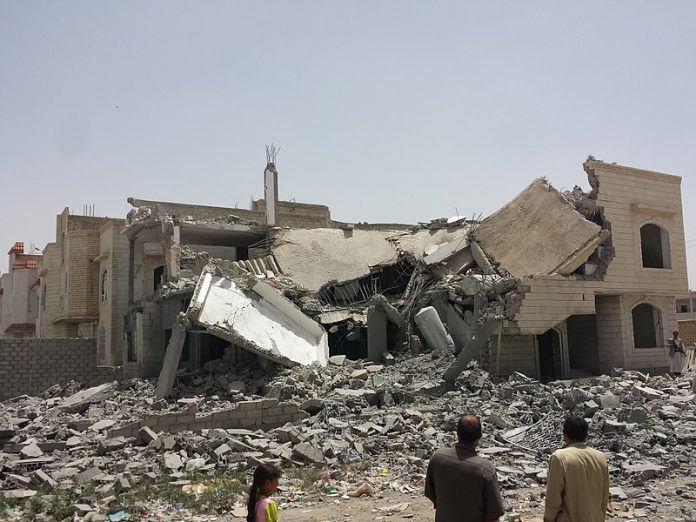The political crisis ignited by the conflict which began in 2014 in Yemen, the poorest country in the Middle East, has dealt a big blow to the country’s infrastructure, basic public amenities and services and the economy. With more than 3.5 million people displaced and nearly seventeen million in dire need of food, thousands of Yemeni children have been compelled to live with malnourishment; the deprivation of school and play have added to the agony. “For a child, growing up in Yemen means nothing more than death and destruction,” said Save the Children’s Yousra Semmache in June.
The seriousness of the situation in Yemen can be gauged from the fears of famine which is looming large over the country. According to a recent United Nations report, Yemen was relapsing to “alarming” levels of food insecurity. Further, the pathetic hunger situation arising out of the COVID-19 restrictions, locusts, floods and the underfunding of the humanitarian aid — is not unfounded. Yamenis are caught in a viscious cycle of hunger and food shortage. Eighty percent out of total 30.5 million population depends on humanitarian aid.
The UN in 2018 warned of the extreme famine, leading to an aid reach out process to Yemen with the World Food programme (WFP) providing food to about 13 million people each month. But today reaching out to Yemenis has become a risky affair because of the renewed violence and insufficient aid funding. The WFP in April reduced the food aid to alternate months to a half in north Yemen; worse, the nutrition services for 2.5 million children are likely to stop towards the end of August. Insufficient food supply will not only increase the level of malnutrition but also the number of malnourished children across the war-torn country.
Under an analysis of the UN’s IPC (Integrated Food Security Phase Classification), 40 percent of south Yemen is in danger of facing high levels of severe food insecurity from July to December, a 15 percent rise from 25 percent in February-April.
Apart from hunger and food-insecurity, death and destruction refuses to stop in Yemen. While the Yemenis are finding it difficult to escape death, the outbreak of deadly diseases like COVID-19, cholera and dangue fever are on the rise. Though this UN declared world’s worst humanitarian crisis has been overshadowed by the ongoing coronavirus crisis, it is to be noted that millions of lives are in danger and inaction at this stage can push the Yemen Crisis out of control. The war-stricken Yemenis are in desperate need of humanitarian aid in the form of food, water, medicine and security.
The end to the six-year-old conflict is not in sight and the warring parties — government and non-government forces look uncompromising on their respective stances. It is worthwhile to note that the conflict has seen the destruction of public infrastructure such as schools, hospitals and the stoppage of basic supplies to the affected people apart from rendering nearly 3.6 million people homeless. According to the Yemen Data Project, more than 17,500 civilians were killed and injured since 2015, and many of the civilians killed in air strikes were women and children. More than 20 million people in Yemen are experiencing food insecurity; 10 million of them are at risk of famine.
Pertinently, the violence in Yemen began well before the North and South Yemen — two separate countries united in 1990 to form the present Yemen. Though the union was seen as a positive breakthrough, it did not mark the end of the fighting which now continues for the control over Yemen with the government and the non-government forces engaged in a rampant tug of war. Consequently caught in the smithy of death and displacement of its citizens, the country has witnessed crisis after crisis for food, water and medicine. Even before the ongoing conflict, Yemen was experiencing severe political instability, poor governance, unemployment, underdevelopment, corruption and starvation; half of its population lived below the poverty line.
As if these challenges were not enough, Yemen , like scores of other countries in the world came under the severe outbreak of COVID-19, adding to the woes of the people of Yemen having more than 60 percent devastated healthcare mechanism and infrastructure from the ongoing conflict. Given the rapid transmission of COVID-19 even in the countries with robust health infrastructure, Yemenis are especially vulnerable to the rampant spread of the illness — mainly for their weak heathcare facilities. In the words of Steve Claborne, Mercy Corps County Director, “only half of Yemen’s health centers are operational, and are already struggling to cope with overwhelming numbers of patients suffering from malnutrition, cholera, dengue fever and injuries of war.” The situation is so dangerous that the UN in 2017 said that a child under the age of five was losing life in Yemen every ten minutes due to hunger, violence and disease.
In 2020, the Famine Early Warning Systems Network which measures food insecurity worldwide said that the famine could be announced in Yemen if the situation worsened further. To declare a famine, about 20 percent of a region’s population is required to suffer chronic shortage of food. Yemen looks set to see famine decleared because the abysmal conditions of food shortage and insecurity have overtaken the country with thousands of people continuously going out of work while the humanitarian aid misses the accessibility.
Yemen’s fragile economy has been heavily impacted ; thousands of families do not have a steady source of income while many public servants have not received a regular salary in several years. The country’s failing economy has worsened the humanitarian crisis. September 2018 saw a wave of demonstrations spreading across the south of Yemen, with people protesting against corruption and blaming the government for the deterioration of the economy, which has left the vast majority of Yemenis unable to buy basic commodities.
The views and opinions expressed in this article are those of the author.

Sheikh Shabir Kulgami is a Kashmiri (Indian) political commentator, analyst and columnist. He writes extensively on South Asia.


